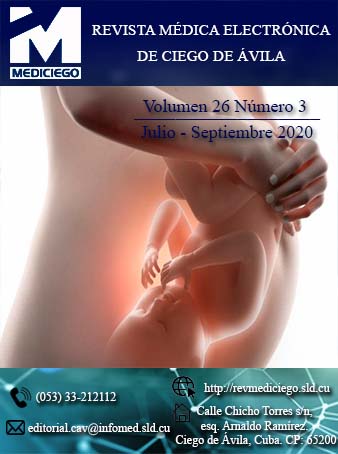Probability model of death from secondary peritonitis
Abstract
Introduction: secondary peritonitis are frequent and have a high lethality.
Objective: to corroborate the practical value of the probability model of death from secondary peritonitis, previously validated by specialists.
Methods: a prospective cohort-type epidemiological risk study was carried out in four stages at the Hospital “Dr. Agostinho Netoˮ, in 2016 and 2017. The population was made up of all patients with secondary peritonitis, grouped according to whether they were discharged dead (cases n =18) or alive (controls n =58). The variables most related to the probability that the patient died were specified. The absolute risk of each variable was calculated. The designed model was validated in workshops with specialists and, later, applied in healthcare practice. The ethical precepts were fulfilled.
Results: the absolute risk of the variables most associated with the prognosis of dying were: multi-organ failure (17,8 %), fecaloid peritoneal fluid (7,8 %) and septic shock (7,3 %). All specialists (100,0 %) evaluated the model as adequate, and its application corroborated its level of precision in terms of sensitivity (92,8 % CI 95,0 % 75,0-100,0 p <0,01) and specificity (98,8 % CI 95,0 % 77,8-100.0 p <0,001).
Conclusions: the practical value of the model of probability of death due to secondary peritonitis designed was corroborated, previous validation of its scientific-methodological relevance by specialists.Downloads
Published
How to Cite
Issue
Section
License
Copyright (c) 2021 Reinaldo Elias Sierra

This work is licensed under a Creative Commons Attribution-NonCommercial 4.0 International License.
Those authors who have publications with this journal accept the following terms of the License CC Attribution-NonCommercial 4.0 International (CC BY-NC 4.0):
You are free to:
- Share — copy and redistribute the material in any medium or format for any purpose, even commercially.
- Adapt — remix, transform, and build upon the material for any purpose, even commercially.
The licensor cannot revoke these freedoms as long as you follow the license terms.
Under the following terms:
- Attribution — You must give appropriate credit , provide a link to the license, and indicate if changes were made . You may do so in any reasonable manner, but not in any way that suggests the licensor endorses you or your use
- No additional restrictions — You may not apply legal terms or technological measures that legally restrict others from doing anything the license permits.
The journal is not responsible for the opinions and concepts expressed in the works, which are the exclusive responsibility of the authors. The Editor, with the assistance of the Editorial Committee, reserves the right to suggest or request advisable or necessary modifications. Original scientific works are accepted for publication, as are the results of research of interest that have not been published or sent to another journal for the same purpose.
The mention of trademarks of specific equipment, instruments or materials is for identification purposes, and there is no promotional commitment in relation to them, neither by the authors nor by the editor.






















